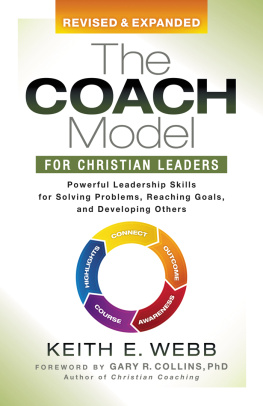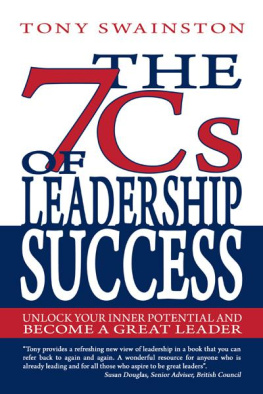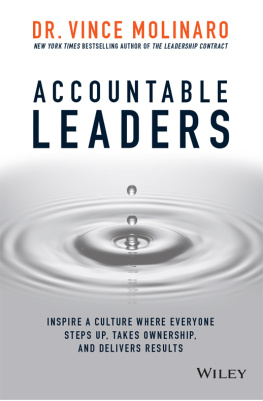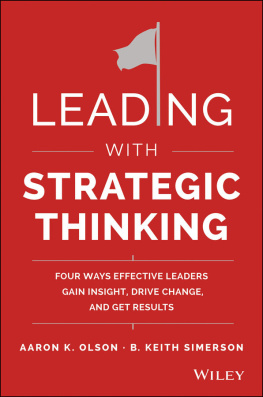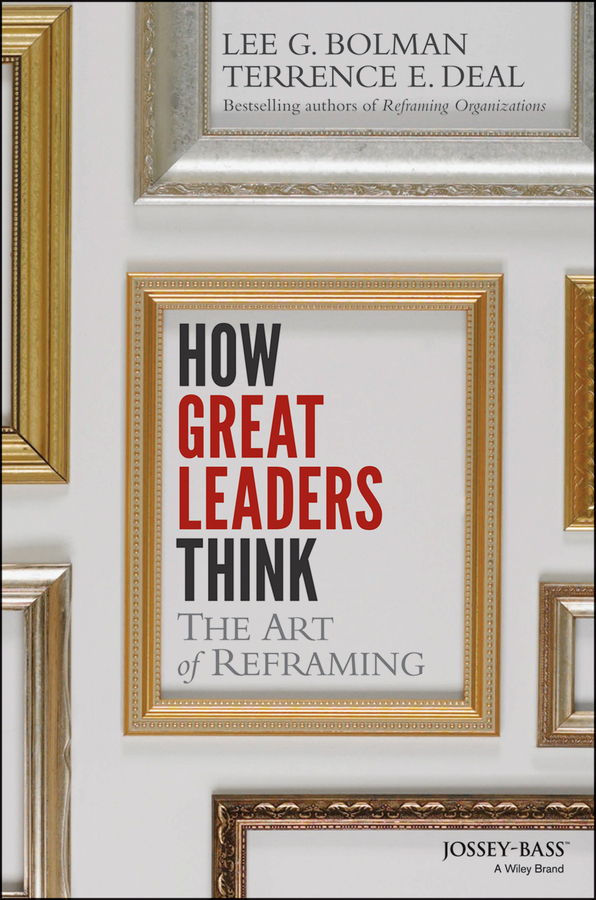
Contents
List of Illustrations
List of Exhibits
Pages
Guide

How Great Leaders Think
The Art of Reframing
Lee G. Bolman
Terrence E. Deal
Cover design by Wiley
Cover image Tetra Images/Getty Images
Copyright 2014 by John Wiley & Sons, Inc. All rights reserved.
Published by Jossey-Bass
A Wiley Brand
One Montgomery Street, Suite 1200, San Francisco, CA 94104-4594www.josseybass.com
No part of this publication may be reproduced, stored in a retrieval system, or transmitted in any form or by any means, electronic, mechanical, photocopying, recording, scanning, or otherwise, except as permitted under Section 107 or 108 of the 1976 United States Copyright Act, without either the prior written permission of the publisher, or authorization through payment of the appropriate per-copy fee to the Copyright Clearance Center, Inc., 222 Rosewood Drive, Danvers, MA 01923, 978-750-8400, fax 978-646-8600, or on the Web at www.copyright.com. Requests to the publisher for permission should be addressed to the Permissions Department, John Wiley & Sons, Inc., 111 River Street, Hoboken, NJ 07030, 201-748-6011, fax 201-748-6008, or online at www.wiley.com/go/permissions.
Limit of Liability/Disclaimer of Warranty: While the publisher and author have used their best efforts in preparing this book, they make no representations or warranties with respect to the accuracy or completeness of the contents of this book and specifically disclaim any implied warranties of merchantability or fitness for a particular purpose. No warranty may be created or extended by sales representatives or written sales materials. The advice and strategies contained herein may not be suitable for your situation. You should consult with a professional where appropriate. Neither the publisher nor author shall be liable for any loss of profit or any other commercial damages, including but not limited to special, incidental, consequential, or other damages. Readers should be aware that Internet Web sites offered as citations and/or sources for further information may have changed or disappeared between the time this was written and when it is read.
Jossey-Bass books and products are available through most bookstores. To contact Jossey-Bass directly call our Customer Care Department within the U.S. at 800-956-7739, outside the U.S. at 317-572-3986, or fax 317-572-4002.
Wiley publishes in a variety of print and electronic formats and by print-on-demand. Some material included with standard print versions of this book may not be included in e-books or in print-on-demand. If this book refers to media such as a CD or DVD that is not included in the version you purchased, you may download this material at http://booksupport.wiley.com. For more information about Wiley products, visit www.wiley.com.
Library of Congress Cataloging-in-Publication Data
Bolman, Lee G.
How great leaders think : the art of reframing / Lee G. Bolman, Terrence E. Deal.
pages cm
Includes index.
ISBN 978-1-118-14098-7 (hardback); ISBN 978-1-118-28450-6; ISBN 978-1-118-28223-6
1. Leadership. 2. Organizational change. I. Deal, Terrence E. II. Title.
HD57.7.B6393 2014
658.4092dc23
2014013595
PREFACE
This book has a simple message:
- Good thinking is the starting point for good leadership.
- Leaders who can reframelook at the same thing from multiple perspectivesthink better. They create a lucid portrait of whats going on around them and have a clearer vision of whats needed to achieve desired results.
- Leaders can see and do more when they know how to negotiate four key areas of the leadership terrain: structural, human resource, political, and symbolic.
This book answers a request weve often heard from readers and fans of our work who have asked for a shorter, more applied version of Reframing Organizations. This new book is a compact overview of our ideas about reframing and our four-frame model, with a focus on leadership. Because storytelling is often the best form of teaching, we use cases and examples, many of them from iconic leaders, to provide realistic lessons about how great leaders think and act.
This work appears thirty years after we published our first book (with the ungainly title Modern Approaches to Understanding and Managing Organizations). Back then, we hoped we might be onto something. Our ideas were still evolving, but we believed that they captured much of the existing research on organizations and leadership, and we were encouraged by former students who were starting to send positive reports back from the field. Weve learned a lot in the years since, and were even more confident that our framework has breadth and power. Readers, colleagues, students, clients, and workshop participants continue to report that our ideas are useful, even career saving, in the heat of practice. Their support and input has taught us and sustained us along the way. So has our long-term partnership. Book writing can be rewarding, but its hard work that intersperses epiphanies and moments of joy with roadblocks and dark times when nothing seems to work. Its a lot easier with a partner, and our respect and affection for each other has helped us sustain a mostly long-distance writing relationship through the decades.
ACKNOWLEDGMENTS
Wed like to thank all the people around the world whove contributed to our work, but the list is too long and our memories too short. Weve had wonderful colleagues and students at Berkeley, Carnegie-Mellon, Harvard, Stanford, University of La Verne, the University of MissouriKansas City, the University of Southern California, Vanderbilt, and Yale, and were still grateful to all of them. Theyve given us invaluable criticism, challenge, and support over the years.
Ellen Harris took time away from her work at Harvard and Outward Bound to support this project, offer insights and ideas, and generously give us feedback on our manuscript. As always, Lee is grateful to Dave Brown, Phil Mirvis, Barry Oshry, Tim Hall, Bill Kahn, and Todd Jick of the Brookline Circle, now in its fourth decade of searching for joy and meaning in lives devoted to the study of leadership and organizations.
Many of Lees colleagues at UMKCs Bloch School have provided invaluable support and input, including Dave Cornell, Nancy Day, Dave Donnelly, Doranne Hudson, Clancy Martin, Dave Renz, Will Self, Marilyn Taylor, and Sidne Ward. Bruce Kay continues to help Lee stay sane and productive.
Lee offers special thanks to Henry Bloch for his friendship and for endowing the Marion Bloch/Missouri Chair that Lee has been honored to occupy since 1993. Henry created the chair in honor of his wife, Marion, a truly remarkable woman who died too soon in 2013.
Terry continues to receive excellent counsel and advice from colleagues scattered in various places: Devorah Lieberman, Jack Meek, Peggy Redman, Donna Redman, and Julie Wheeler, University of La Verne; Sharon Conley, University of California, Santa Barbara; Kent Petersen, emeritus, University of Wisconsin; Warren Bennis, Gib Hentscke, and Stu Gothald, University of Southern California; Regina Pacheco, University of Phoenix; Patrick Faverty and Eric Prather, SLOs Friday Afternoon Think Puddle.
Next page



